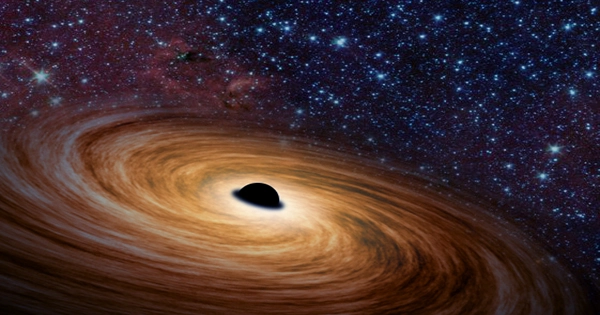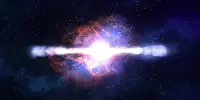A new study led by Northwestern University is redefining the way astrophysicists think about the eating habits of supermassive black holes.
Previously, physicists assumed that black holes ate slowly, but recent simulations show that black holes devoured faster than popular thinking predicts.
The paper, “Nozzle shocks, disk tearing, and streamers drive rapid accretion in 3D GRMHD simulations of warped thin disks,” was published in The Astrophysical Journal.
Spining black holes, according to recent high-resolution 3D models, twist up the surrounding space-time, eventually ripping apart the furious swirl of gas (or accretion disk) that encircles and feeds them. This causes the disk to tear into inner and outer subdisks. The inner ring is devoured first by black holes. The eating process is then repeated as debris from the outer subdisk spills inward to fill the space left by the completely devoured inner ring.

One cycle of the continually recurring eat-refill-eat process takes only months, a startlingly short period when compared to the hundreds of years previously estimated by academics.
This new discovery could help explain the dramatic behavior of some of the night sky’s brightest objects, such as quasars, which suddenly flare up and then vanish without explanation.
“Classical accretion disk theory predicts that the disk evolves slowly,” said Northwestern researcher Nick Kaaz. “However, some quasars—which are caused by black holes eating gas from their accretion disks—appear to change dramatically over time scales ranging from months to years.” This is a huge difference. It appears like the inner half of the disk, where the majority of the light comes from, is destroyed and then replenished. This dramatic variation cannot be explained by classical accretion disk theory. However, the events we observe in our simulations may be able to explain this. The rapid brightening and fading are consistent with the destruction of the disk’s interior regions.”
Kaaz is a graduate student in astronomy at Northwestern’s Weinberg College of Arts and Sciences and a member of the Center for Interdisciplinary Exploration and Research in Astrophysics (CIERA). He works with paper co-author Alexander Tchekhovskoy, an associate professor of physics and astronomy at Weinberg and a CIERA member.
Mistaken assumptions: Accretion disks that surround black holes are physically complex things that are extremely difficult to model. Conventional theory has failed to explain why these disks flare so brightly and then dim abruptly—sometimes completely disappearing.
Previous studies incorrectly assumed that accretion disks are relatively organized. Gas and particles swirl around the black hole in these models, in the same plane as the black hole and in the same direction as the black hole’s spin. Then, over hundreds to hundreds of millions of years, gas particles spiral towards the black hole, feeding it.
“For decades, people assumed that accretion disks were aligned with the rotation of the black hole,” Kaaz added. “But the gas that feeds these black holes doesn’t always know which way the black hole is rotating, so why would they be aligned automatically?” Changing the alignment significantly alters the picture.”
The simulation, which is one of the highest-resolution accretion disk models to date, shows that the regions surrounding the black hole are far noisier and more turbulent than previously assumed.
More like a gyroscope, less like a plate: The researchers ran a 3D general relativistic magnetohydrodynamics (GRMHD) simulation of a thin, tilted accretion disk on Summit, one of the world’s largest supercomputers situated at Oak Ridge National Laboratory. While prior simulations were insufficient to encompass all of the physics required to build a realistic black hole, the Northwestern-led model combines gas dynamics, magnetic fields, and general relativity to provide a more complete picture.
“Black holes are extreme general relativistic objects that affect space-time around them,” according to Kaaz. “As a result, when they rotate, they drag the space around them like a giant carousel, forcing it to rotate as well—a phenomenon known as ‘frame-dragging.'” This produces a very strong effect close to the black hole, which weakens as one moves away.”
Frame-dragging causes the entire disk to wobble in circles, much like a gyroscope. However, the core disk wants to wobble considerably faster than the surrounding parts. Because of this misalignment of forces, the entire disk warps, allowing gas from various areas of the disk to clash. The collisions produce brilliant shocks that aggressively propel material closer to the black hole.
As the warping worsens, the innermost section of the accretion disk wobbles faster and faster until it separates from the rest of the disk. The subtasks then begin to evolve independently of one another, according to the latest simulations. Instead of moving in unison like a flat plate around the black hole, the subtasks wobble at varying speeds and angles, much like the wheels of a gyroscope.
“When the inner disk tears off, it will process independently,” explained Kaaz. “It processes faster because it’s closer to the black hole, and it’s small, so it’s easier to move.”
‘Where the black hole triumphs: According to the new simulation, the feeding frenzy begins at the tearing region, where the inner and outer sub disks separate. While friction tries to keep the disk together, the spinning black hole’s twisting of space-time wants to rip it apart.
“There is competition between the rotation of the black hole and friction and pressure inside the disk,” Kaaz explained. “The black hole triumphs in the tearing region.” The inner and outer disks come into contact with each other. The outer disk shaves away layers of the inner disk, pushing it in.”
The subtasks now intersect at various angles. The substance is poured on top of the inner disk by the outer disk. This additional mass also forces the inner disk toward the black hole, where it is eaten. The black hole’s gravity then sucks gas from the outer region into the now-empty inner region to replenish it.
The quasar connection: According to Kaaz, these quick cycles of eat-refill-eat could explain so-called “changing-look” quasars. Quasars are extraordinarily bright objects that emit 1,000 times the energy of the Milky Way’s 200 billion to 400 billion stars combined. Quasars with changing appearances are considerably more severe. They appear to turn on and off over months—a very short period of time for a conventional quasar.
Although classical theory made assumptions about how quickly accretion disks evolve and alter brightness, measurements of changing-look quasars show that they evolve far faster.
“The inner region of an accretion disk, where most of the brightness comes from, can totally disappear—really quickly over months,” Kaaz explained. “We basically see it vanish completely. The system loses its brightness. Then it brightens again, and the cycle begins again. Conventional theory does not explain why it evaporates in the first place, nor does it explain how quickly it refills.”
The new models may not only explain quasars, but they may also answer long-standing mysteries about the mysterious nature of black holes.
“How gas gets to a black hole to feed it is the central question in accretion-disk physics,” said Kaaz. “If you know how that happens, it will tell you how long the disk lasts, how bright it is, and what the light should look like when we observe it with telescopes.”















